Low back pain is a common phenomenon that occurs regardless of age, but is more common in adults. There are many causes - from physiological factors to disease. Sometimes back pain appears momentarily and passes quickly. However, pain in the lumbar region can be a sign of serious illness, and in this case, an urgent need to see a doctor.
Reason
There are many causes of acute lower back pain, it is individual for each sufferer. The most important are diseases and changes in the spine, which can react with irreversible consequences.
Basic (most common)
The most common reason is:
- Osteochondrosis. The awkward movement puts pressure on the roots of the spinal cord. Burning and grumbling do not stop during the day, if you lift something heavy, there is only pain in the lower back.
- Herniated Disc. Usually, the hernia is localized in the lower back, and the movement of the trunk suddenly brings compression to the nerve root.
- Radiculitis. With lumbosacral radiculitis, shooting pain syndrome occurs. This provokes heavy or unsuccessful lifting movements. Sharp pain restricts the patient's movement until he or she is unable to straighten the body and remains in the same position as when the attack occurred.
- Spinal displacement. This problem is characterized by pain in the lower back and, slightly lower, stiffness of movement. This pathology is accompanied by disorders of urinary function and intestinal function.
- Facet Syndrome. As the aspect of the intervertebral disc develops above and below, the intervertebral foramen decreases. In this case, an unpleasant sensation arises that comes suddenly and occurs more than once a month. Leaning back, the patient experiences back discomfort.
- Epidural abscess. The accumulation of pus in the spinal cord occurs due to infectious diseases of the urinary tract. In addition to pain, fever, weakness and increased body temperature occur.
This is the cause - the result of disease of the spinal cord.
The lower back can get sore due to the difference in leg length of 2-3 cm. It is difficult for a person to move, pain in the back due to the constant curvature of the spine.
Excessive load and physical fatigue
In addition to serious illness, severe pain in the lumbar spine is also caused by excessive load and a sharp inclination of the trunk forward. Also, this problem arises when the effect of temperature on the body is violated. The causes of this pain are:
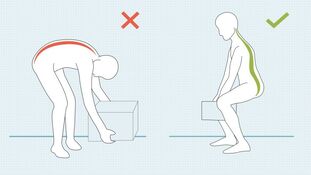
- Stretching muscles. Deterioration of muscle tension in the lower back occurs due to physical load. Squeezing muscles causes pain and reduces mobility. This problem occurs in athletes and people involved in intensive work.
- Neuralgia. Back hypothermia leads to neuralgia - irritation or compression of the nerves. The pathology manifests itself in different ways: sometimes in the form of seizures, accompanied by redness in the affected area, tremors, severe tissue edema and sweating.
- Myositis. Lumbar pain and discomfort begin at night, as well as with a sharp rise, with changes in weather conditions, after hypothermia and too much energy.
Frequent colds, decreased immunity, spinal trauma after a stroke or fall, both fresh and old, can provoke an attack.
Internal organ disorders
Occasional pain in the lumbar zone due to damage to other organs: heart, liver, kidneys, lungs, gallbladder. During inhalation, the pain syndrome of the lumbar region deviates along all nerve channels. Often the cause of this pathology is:
- Pyelonephritis. This is an infectious inflammation of the kidneys and urinary tract. Usually the pain is dull, but the attack comes with chills, weakness, nausea and vomiting, fever.
- Urolithiasis. The problem manifests itself as a sharp pain that suddenly becomes unbearable with walking and hard work. The attack is accompanied by nausea, vomiting, and blood in the urine.
- Ectopic Pregnancy. If there is a rupture of the fallopian tubes with a miscarriage, there is shooting pain radiating to the groin and rectum. Bursting is accompanied by loss of consciousness, and with tubal miscarriage, hematomas form in the peritoneal cavity.
- Pelvioperitonitis. This is a temporary inflammatory process that complements the uterus. The woman was experiencing excruciating pain in her groin and back. In addition to the unpleasant sensations, a feeling of cold, fever and palpitations is added.
- Tumors of various origins. Cancer with metastasis provokes a painful attack when pressure is applied to the nerve endings. Often there are no early signs of the disease.
Internal organ lesions with severe pain in the lower back are more difficult to diagnose. Therefore, you should immediately contact a specialist or call an ambulance. In some cases, delays can lead to serious health problems and even death.
Pain in the lower back is felt in almost all pregnant women. This is due to the restructuring of the body and the increase in load on it. Also, hard or complicated work can be the cause.
Symptoms of possible disease
Pain syndrome most often appears with a background of pinched nerves, osteochondrosis, deformities and degenerative changes in the intervertebral disc, irritation of nerve roots. Muscle cramps can also cause back discomfort in the lumbar region. Symptomatic features of different diseases:
- With lumbago, changes begin in the lumbar vertebra. Initially, acute pain can be controlled with medication. However, movement remains controlled.
- With sciatica, the symptoms move lower - to the upper surface of the legs and back. If there is no timely treatment, then the disease becomes a constant companion and can lead to other diseases.
- Osteochondrosis provokes the development of other spinal diseases. Thus, pain can occur not only in the lower back, but also spread throughout the post.
- Scoliosis is characterized by skeletal curvature, degenerative changes. The chronic form may not be symptomatic, in other cases there is pain in the bones.
- Dull and attractive pain is typical for diseases of internal organs (especially the genitourinary system and kidneys), benign and malignant tumors.
- With spondylitis, the pain is dull, aching, very weak at first. At the onset of the disease, pain in the lower back, movement becomes limited. Gradually, the health condition worsened, inflammation became more pronounced, it was difficult to move, and even the minimum load was difficult to give.
- In spinal tuberculosis, in addition to pain, body temperature rises. A person feels tired, weak, weak, appetite worsens. At night, there is severe sweating, the urge to urinate.
Display
Pain can only be localized in one place or "spread" in the abdomen, spine and lower back. Acute symptoms, in the form of lumbago, dull and sore, surround. It depends on the disease or pathological process.
Pain can be intermittent. Usually this is due to physical activity, physiological features, increased chronic pathology. Persistent chronic pain occurs against the background of various diseases of internal organs, with vascular lesions, deformities of the musculoskeletal system.
Sharp
Sharp, strong, and intense pain causes limited movement. During such an attack, a person freezes in one position and is unable to move. Even a little stirring increases the pain that is already unbearable. This syndrome is called lumbago. Such symptoms can occur after intense massage or hypothermia.
Whining
Painful pain accompanied by chronic illness, often appearing with spondyloarthrosis. Symptoms usually arise at night, as soon as you wake up or after sitting for a long time in one position.
Interesting and mute
This painful sensation can last a long time, it tires the person. Often they can be tolerant. Dull and attractive pain is rare in osteochondrosis, more so to spinal pathology or damage to internal organs.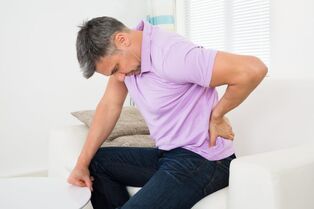 For example, with pielonefritis, the kidney tissue swells profusely, stretching capsules, causing back pain.
For example, with pielonefritis, the kidney tissue swells profusely, stretching capsules, causing back pain.
Kayap
Symptoms can appear in one place and radiate throughout the peritoneal area, "spreading" in the back. Girdle pain also affects the entire lower back. Without additional diagnostics, symptoms can be confused with diseases of the spine and joints. However, girdle pain usually causes pathology of internal organs.
Localization of pain
In ankylosing spondyloarthritis, symptoms appear mainly in the lower back. Basically, the pain occurs in the morning, it can start even at late at night and gradually increase, all the way to the lower back. Also, discomfort in the lower back accompanies diseases of the pelvic organs, tail trauma, urological and gynecological pathology, with the threat of miscarriage, after childbirth.
At the top of the symptomology occurs with kyphosis, trauma, muscle myositis, osteochondrosis, infectious processes or tumors. Even so, the causes are pathology of the gastrointestinal tract, gynecological diseases, kidney and heart, pneumonia, pleurisy, influenza, ARVI.
Pain in the left or right side of the lower back appears due to disorders of the central nervous system, diseases of the spine and internal organs. Symptoms will appear from the side of the affected area. The appearance of immediate negative sensations on the left and right sides accompanies pleurisy, hepatitis, pneumonia, cholecystitis, prostate inflammation, and in women - complement.
Features in women and men
Some types of pain only appear in women. For example, with gynecological diseases. Adnexitis is characterized by the appearance of discomfort in the lower abdomen. In this case, the pain sometimes radiates to the lower back. During pregnancy, primary symptomatology occurs in the groin area, and radiates to the lower back due to increased load on the spinal space. 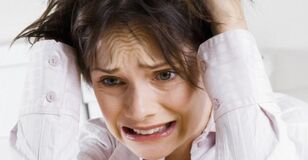 Low back pain occurs during childbirth, with the threat of miscarriage, in late pregnancy.
Low back pain occurs during childbirth, with the threat of miscarriage, in late pregnancy.
Menopause can be a cause of back pain in the lumbar region when menstruation stops. The appearance of symptoms in the lumbar region is influenced by surge in estrogen levels, circulatory disorders, early stages of osteochondrosis, hernias and other spinal diseases. Pain also arises as a result of stress, in which women are more vulnerable than men. In this case, the symptoms are periodic.
In men, back pain is more often associated with professional activity, risk - great physical activity, hypothermia, working out plans. There are a number of diseases that provoke the onset of negative symptoms in the lower back. With prostatitis, the pain first appears in the anal area, but can radiate to the back. Epididymitis is characterized by an inflammatory process. Initially, pain appears in the groin area, then radiates to the lower back. At the same time, this is accompanied by an increase in temperature and swelling of the scrotum.
First Aid
What to do if severe back pain appears spontaneously? The following steps should be taken immediately:
- Rest your back completely.
- Take a comfortable position, preferably lying on a hard surface.
- You can put ice on the lower back, but before that put it on a folded cloth in 3-4 layers. This can only be done if the cause of the pain is not an organ infection.
- Apply a soothing analgesic gel to the affected area.
- Take painkillers.
All these activities will help get rid of severe back pain. But specialist consultation and examination should be done to identify the true cause of this attack and prescribe adequate treatment.
What not to do
If you suddenly experience a painful sensation in the back, doctors do not recommend using ointments and heating gels at once. They stimulate blood flow to the sore spot, which contributes to increased swelling, and then increased pain. Before visiting a doctor or the arrival of an ambulance, the following are completely excluded and definite:
- Do the exercises of your choice.
- Wash in a sauna or steam bath, do not use a contrast cleanser.
- Drink alcohol to relieve pain.
Only a doctor after examination and diagnosis is entitled to provide treatment for back pain.
What to do next, which doctor should I see?
First you need to see a therapist. He performed an initial examination, prescribed the necessary tests and, with the results obtained, sent him to a narrow specialist - a traumatologist, a surgeon, a neuropathologist. If pain is associated with malignant formation, consultation with an oncologist is required. When the pathology of the gastrointestinal tract becomes the cause - gastroenterologist, with the disease of women - gynecologists, men - urologists or proctologists.
Inspections and inspections
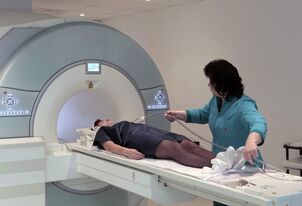
To find out why the lower back hurts, an initial visual examination is performed first, followed by palpation. With its help, you can determine the localization of symptoms. The patient describes the nature of the pain, the duration of the attack, after which it can appear (fall, physical activity). Further studies were conducted:
- Blood test. It can indicate inflammatory processes, the presence of infections, tumors.
- Urinalisis. Allows you to exclude kidney pathology. In case of poor analysis, ultrasound is also prescribed.
- X-ray. Allows you to identify inflammatory processes, spinal diseases, injuries, cracks, fractures, pinched nerves. Ideally, X-rays of the spine and pelvic bones are performed.
- CT. Tomography is more informative than X-rays, it can show small defects, 3D pictures are made. In this case, all the bone structures can be clearly seen.
- MRI. Provides an opportunity to explore soft tissue in or near the spine. At the same time, the condition of the spinal cord, nerve roots, ligaments, muscles is examined. Hernia and vascular changes are clearly visible.
However, CT and MRI are only shown for severe symptoms. Usually, x-rays or ultrasound, blood and urine laboratory tests are sufficient.
Basic therapy
If lower back pain is caused by a problem in the spine, then comprehensive pathological treatment is used. This includes the following activities:
- spine-friendly regimen organization;
- carry out manual therapy;
- use of therapeutic massage;
- physiotherapy and reflexology sessions: acupuncture, UHF and others;
- drug therapy: medications, ointments, restrictions;
- wear a special corset, if necessary;
- doing recovery gymnastics.
The main focus is drug therapy, which aims primarily to eliminate negative symptoms and relieve inflammation. As additional funds, physiotherapy, massage, exercise therapy are prescribed. In difficult cases, surgery may be required.
Drug Treatment
Anti-inflammatory is the first choice for back pain. They also relieve pain. Analgesics can be prescribed at the same time. In addition, muscle relaxants are prescribed. To reduce the degenerative process in cartilage, chondroprotectors are prescribed. To relieve pain, drug blocking is sometimes done based on pain medication.
Topical ointments and gels are grouped into the following types:
- Means based on non-steroidal anti-inflammatory components.
- A combination of preparations with anti-inflammatory effects and tissue cell recovery.
- Anesthetic and irritating agents.
- Homeopathic medicine.
- Chondroprotectors that promote cartilage tissue recovery.
- Massage products (cosmetics).
It is important to know that this method can relieve pain, but does not cure the root. For example, damage to internal organs, if lower back pain appears due to this cause. In this case, you should undergo an examination, and a specialist will prescribe effective treatment for this particular pathology.
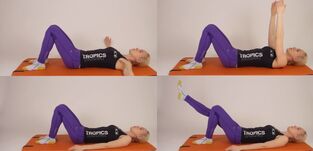
Exercise and massage
Exercise therapy (therapeutic gymnastics) and massage are recommended to strengthen the skeletal muscles of the back, normalize blood circulation, and improve tone. Exercise prevents back and back pain. Exercise therapy complexes are individually selected. Massage strengthens the effectiveness of training, restores elasticity and ligament flexibility. Combining it with a bathtub or sauna can only be allowed on medical advice.
Physiotherapy
Physiotherapy methods are prescribed only after an acute attack of lower back pain has been relieved. Then the procedure helps reduce or prevent deterioration. The following is used as physiotherapy:
- mud therapy;
- electrophoresis;
- balneotherapy;
- muscle electrical stimulation;
- fonoforesis (ultrasound);
- paraffin treatment;
- reflexology;
- amplipulse therapy.
This procedure helps reduce swelling, has analgesic effects, improves blood circulation, relaxes muscles, and normalizes metabolic processes and lymph flow.
Surgery
The absolute indication for surgery is cauda equina syndrome, when urinary and fecal incontinence occurs, and numbness appears in the perineum. Also, intervention is needed if drug treatment is ineffective, lower back pain persists for more than six months and begins to radiate to the feet. Surgical surgery is also performed in the presence of a hernia.

People's solution
In addition, folk remedies can be used - infusions, decoctions of medicinal herbs. Compresses are made (for example, from chopped onions, fresh burdock leaves, boiled potatoes with carrots, mustard). Rub with eucalyptus and burdock, warm honey, cologne mixture, red pepper, iodine and valerian are used. For internal use, it is recommended to drink vodka with a saber or a decoction of wheat with coriander and milk.
Expert recommendations
If the pain is felt for at least 3 months, it is considered acute pain. The following tips will help you speed up recovery from acute lower back pain and reduce intensity:
- It is important to give the patient complete rest for 2-3 days. You need to sleep and take a comfortable position: lie on your side and put a pillow between your knees, or lie on your back and put a pillow under your knees. You can not stand still all day - it is recommended to wake up every 2-3 hours and warm up for 10-15 minutes.
- If pain is intolerable, painkillers and anti-inflammatory medications should be taken regularly. Take it only when the pain is getting worse, you may not achieve the desired effect.
- Bathe in warm water every 3 hours or use a heater for 10-15 minutes, or even cold, helps - this improves blood circulation, reduces pain and inflammation.
When you feel better, you should gradually return to your normal way of life. Lying too long in bed contributes to muscle atrophy, and this exacerbates the disease. You can train your body by walking or walking in a simulator - this is the simplest exercise for lumbar pain.
If lower back pain is not an independent disease, then this is a result of a serious illness found in the body. Therefore, you should immediately contact a medical institution to identify competent pathology and treatment.































